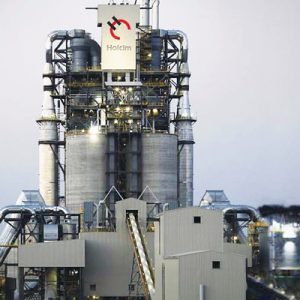 Holcim (US) operates the largest single-kiln line cement-producing facility in the world: the Ste. Genevieve plant in Missouri. When the facility went on-stream in 2009, it required 28 large variable frequency drives (VFDs), with power ratings of 350 to 5,500 hp, to power its fans, mill drives and kiln drives.
Holcim (US) operates the largest single-kiln line cement-producing facility in the world: the Ste. Genevieve plant in Missouri. When the facility went on-stream in 2009, it required 28 large variable frequency drives (VFDs), with power ratings of 350 to 5,500 hp, to power its fans, mill drives and kiln drives.
Ste. Genevieve produces hundreds of tons of cement per hour at operating temperatures of 2,500 F. Siemens needed to ensure the reliability of this critical application and implement the solution with minimal impact to the plant’s throughput and efficiency.
Siemens worked with Ken Walden, Holcim Ste. Genevieve’s electrical manager, to develop a configuration that would meet the needs of this harsh environment. Siemens recommended 13 GenIIIe VFDs with redundant rank of cell, and 15 GenIV VFDs.
The drives – ranging supply voltage of 4,160 to 13,800 V – feature Advanced Cell Bypass, input contactor/switchgear and electrical door interlocks. Siemens provided factory acceptance testing, commissioning, on-site training and a critical spare parts package.
Plus, Siemens worked with the plant to make sure operations stayed online during startup and commissioning in order to avoid production delays.
Results
The Siemens ROBICON Perfect Harmony drives at Holcim Ste. Genevieve demonstrated excellent reliability and efficiency following commissioning. The drives required very little reactive maintenance and have kept the plant producing high volumes of cement.
“We chose Siemens ROBICON Perfect Harmony VFDs because of the manufacturer’s reputation and the drives’ reliability, innovative design, American-made status and price,” said Walden. “And they’ve lived up to their reputation. We definitely made the right choice.”
Benefits
Advanced Cell Bypass allows the drive to bypass any one cell during operation while maintaining the full output voltage. Benefits include:
- Broad compatibility. IGBT-based topology allows the drive to be scaled precisely for a very wide range of voltage and output power.
- Increased energy efficiency. Synchronous transfer reduces stress on the power grid and equipment during simultaneous motor startup.
- Reduced total cost of ownership. 50+ technologies decrease downtime, improve energy efficiency and limit wear and tear – extending the drive’s life to up to 20 years.
- Fast, dependable customer service. Real medium voltage drive technicians provide support throughout the lifecycle, from quoting, commissioning and on-site training to 24/7/365 call center support and nationwide field service.
 |
| The Ste. Genevieve plant (Above) and VFDs (below). |
The Siemens ROBICON Perfect Harmony drive features a series of linked low-voltage cells that build the medium-voltage power output of the drive system. With this topology, the drive can be scaled precisely for a wide range of voltage and output power.
Its ability to bypass any one cell during operation while maintaining the full output voltage offers unsurpassed availability and reliability, the company said. An integral transformer with phase-shifted secondaries eliminates the need for input harmonic filters or power factor compensation.
This results in output voltage so close to perfect sine-wave shape that motors of literally any type – old or new, low-speed or high-speed – can be operated without any additional stress. And the drive’s reliability is further backed by live, U.S.-based support. F
Information courtesy of Siemens Industry Inc.
Ste. Genevieve: A Model Facility
Holcim’s (US) Ste. Genevieve cement plant in Bloomsdale, Mo., began construction in 2005, went on stream mid-2009, and was inaugurated on June 4, 2010. It is a world-class facility with a single-kiln line and has an annual production capacity of 4 million tons of cement, which makes it one of the world’s largest cement manufacturing facilities.
With its own port and loading facilities on the Mississippi, the factory is a model facility in every respect and is highly energy-efficient. Compared with the Holcim (US) plants shut down (Dundee and Clarksville) the improvement per ton of cement equals around 40 percent. CO2-emissions per ton of cement are 10 to 25 percent lower than the norm, mainly due to energy-efficient transportation, with barges handling approximately 75 percent.
Ste. Genevieve, Mo., was chosen as the best site for this new plant for several reasons: a plentiful supply of good-quality limestone, a high-quality workforce, and good access to target markets via key transportation networks including waterway, rail and road. The spine of the waterway network is the Mississippi River, more than 2,300 miles long. This system serves 10 of the 20 largest cities in the United States. The Ste. Genevieve plant has its own slack-water harbor on the Mississippi, allowing efficient and low-cost transportation of 6 million tons of materials annually.
In maintaining Holcim’s commitment to sustainable development, the plant is one of the most environmentally efficient cement production facilities ever operated. Holcim has made major efforts to both minimize emissions and protect air quality along with the conservation and preservation of natural resources. Holcim invested in cutting-edge equipment with high plant efficiencies, optimized raw materials, and energy efficient transportation opportunities.
While about 1,700 acres are permitted for quarry and plant operations, ongoing reclamation will ensure that only a portion is opened at any given time. Holcim has restored more than 60 acres of wetlands on the property. Other than the on-site quarry materials, up to 75 percent of the plant’s materials and products will be received and shipped by river, maximizing both energy and environmental efficiency.
Source: Holcim (US)




